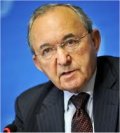alleged to have fired at the demonstrators. It was
reported that some 15 people were killed and more than 50 injured.. This and
other promised programs will require substantial resources in a country that
has a relatively small budget.
The largest rebel group that had refused to sign the peace agreement is known by
its Spanish acronym, ELN. At the beginning of October 2017, two days before the
Pope visited Colombia, ELN joined the peace agreement and agreed to a
ceasefire. A few weeks later, at the end of October 2017, an indigenous leader
was killed, allegedly at the hands of the ELN rebels. This has also had the
effect of undermining confidence in the ceasefire agreed in the framework of
the peace talks.
I have mentioned only two of a number of events that make the peace process so
fragile. It will be further exacerbated by the upcoming 2018 elections for the
Congress on March 11, the first round for the Presidential election on May 27,
and a runoff between the two leaders in the first round set for June 17.
Colombia’s system of proportional representation has spawned a plethora of parties and
presidential nominees. I was informed that more than 32 people have indicated
their interest in running for president. Thus far there are almost 20
registered. To complicate the matter further, FARC is threatening to field a
candidate. Such a move would be calculated to fuel strong feelings on the part
of many Colombians who oppose the peace process.
A leading politician who is strongly against the peace process is former President Álvaro Uribe. He is not
eligible to stand again for president but any candidate anointed by him is
likely to substantially benefit from his charismatic support. The present
president, Juan Manuel Santos, who received the 2016 Nobel Peace Prize for his
efforts to achieve peace in Colombia, comes to the end of his second term and
is also ineligible for reelection. The country is already in election mode and
it appears that pending crucial legislation required to implement the peace
agreement is languishing in the legislature. It thus becomes apparent that the
political situation in Colombia is a difficult, fraught and complex one.
One of the problems brought to my attention by some supporters of the peace process
is that its terms are confusing and not clearly understood by many people. I
would suggest that time is of the essence and that if procedures required to
implement the peace process are not put in place with all due speed, that
process will rapidly bleed support and the country will be back to the state of
destructive war that obtained before the cease fire was negotiated.
It is clearly in the interests of the people of Columbia that the atrocious violence
of the preceding five decades should end. There have been far too many victims.
The cost of implementing the peace process and sustaining the institutions that
have been created to facilitate it is substantial. According to the Los
Angeles Times of March 15, 2017: “In exchange for the rebels' agreeing to
lay down their weapons, the government promised billions of dollars in aid and
education, land reform, rural infrastructure and guaranteed political
representation over the next decade. Santos also committed to protecting the
rebels from reprisals by right-wing paramilitary groups.” The cost of providing
for promised aid to the rebels is estimated to amount to some 5% of the annual
budget.
It is crucial that members of the international community continue to support the
people of Columbia in their pursuit of peace. In particular the United States
Government should in no way reduce its financial and political support for the
peace process. It has consequences, not only for Columbia, but for many
millions of people in the region who have over the decades been affected by
violence and instability in Colombia.

 International
Judicial Monitor
International
Judicial Monitor